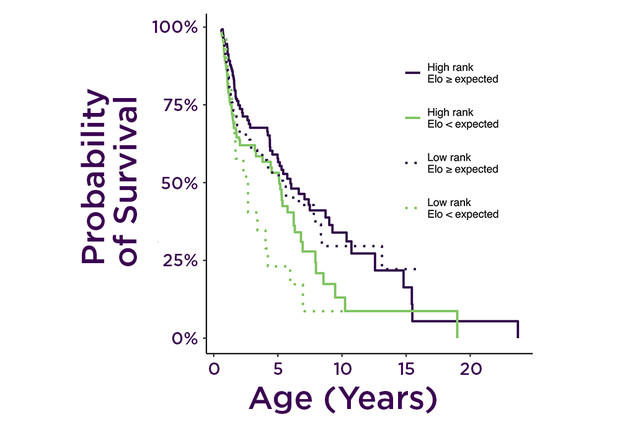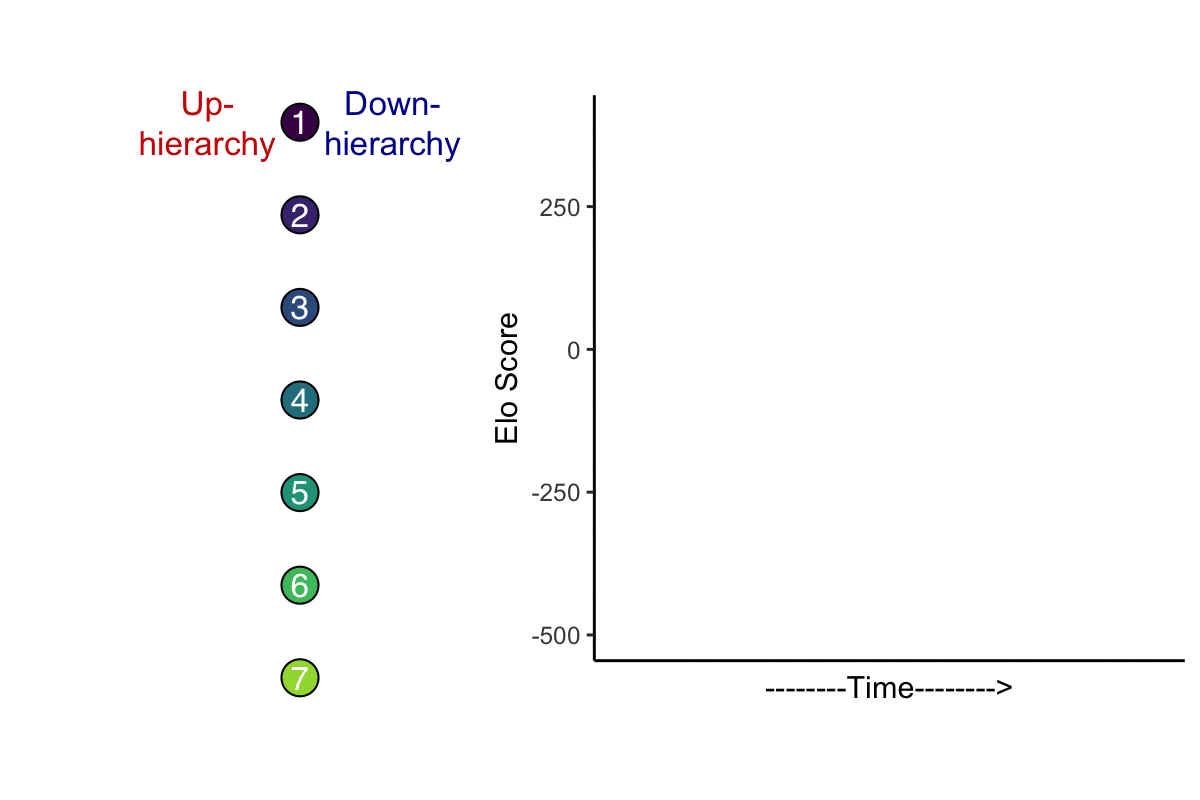Scott Schrage, March 9, 2020
Great expectations? Falling short of status no laughing matter for hyenas
Like all spotted hyena newborns, she spills onto the Kenyan grassland with open eyes and a full set of teeth. But as the daughter of a high-ranking mother in a matriarchal society, she also inherits an advantage over many of the local cubs: an enviable social status.
Within weeks, after moving to a communal den that serves as the hyena equivalent of daycare, she begins engaging and play-fighting with up to 30 of her peers. About 80% of the time, she could be expected to emerge from that daycare with the exact same rank that she entered it — near the top of the local hyena hierarchy.
But a funny thing happens on the way to adulthood.
Over the next seven months or so, she finds herself getting upset by lower seeds in those early displays and tests of social rank, signaling her submission by backing away from challengers with haunches low to the ground and ears pinned to the head.
New research from the University of Nebraska–Lincoln suggests that those upsets are no laughing matter for the spotted hyena — and that, as adulthood approaches, they might even manifest as a matter of life and death.
Nebraska’s Eli Strauss and Daizaburo Shizuka analyzed decades of data from Kenya’s Maasai Mara National Reserve, where Kay Holekamp of Michigan State University has collaborated with local researchers to monitor the social behavior, reproduction and life outcomes of its spotted hyenas since 1988.
Spotted hyenas that underperformed their inherited ranks by falling victim to upsets in their formative months were about 1.5 times more likely to die at any given point than were the hyenas that matched or surpassed their own inherited ranks, the study found. Surprisingly, the pattern held even among spotted hyenas that later managed to restore their inherited ranks, suggesting that the effects of the early upsets somehow persist into adulthood and are independent of the rank itself.
The underperforming hyenas also produced fewer offspring, though the team found that this hit to reproduction seemed to stem mostly from the reduced lifespan. Proceedings of the Royal Society B A graph depicting how underperforming vs. outperforming expectations in contests of social dominance can influence the survival likelihood of spotted hyenas at multiple ages. The two purple lines represent groups of hyenas that generally matched or surpassed expectations; the green lines represent groups that lost contests to lower-ranked peers. (Click to zoom)

“We typically are most interested in dominance in adult animals, because juveniles are still developing,” said Strauss, a postdoctoral researcher in biological sciences. “‘All that’s going to change anyway, so who cares? Let’s measure dominance in adults, because that’s when the rubber hits the road.’ But this is suggesting that the rubber is already hitting the road, and we should really be looking at dominance in juveniles, as well.”
Rank and file
Strauss and Shizuka reached the conclusions with help from the Elo rating system, a popular statistical method for ranking competitors and predicting the outcomes of contests based on given traits. The system is especially responsive to upsets, subtracting more points from a favorite that loses than it awards that same favorite for winning.
Though Elo ratings are most often employed in chess, gaming and professional sports, Strauss and other behavioral ecologists have also applied them in studying contests among animals.

An animation illustrating the occurrences of expected vs. unexpected outcomes among seven spotted hyenas (left) and the associated effects on Elo rating (right). Numbers represent the cubs arranged according to the ranks they inherited from their mothers (1 = highest, 7 = lowest). Over time, upsets of higher-ranked hyenas (red lines, left) become less frequent as the cubs’ actual ranks begin aligning with their inherited ranks. Eli Strauss
“This process is so predictable,” said Strauss, who noted its similarity to the hierarchies of baboons and some other primates. “It’s a really weird thing to be able to look at a baby animal and say, ‘I know exactly who you’re going to be able to dominate when you’re older, and who’s going to be dominating you.’ You could bet money on this, because you would be right most of the time.”
Because of their interest in how juveniles deviated from the expected social paths, Strauss and Shizuka devised a related metric that they call an Elo-deviance score. Years of careful tracking had allowed Holekamp’s team to determine the social status of each mother in a clan and, after accounting for the fact that younger kin outrank their older siblings, also ascertain the expected rank of every juvenile. That, in turn, allowed Strauss and Shizuka to calculate the expected Elo rating of each juvenile — its ranking at roughly 8 months old if it had won every contest when favored and lost every contest when the underdog.
By comparing a juvenile’s expected Elo rating against the Elo rating that the juvenile actually earned, the researchers calculated its Elo-deviance score. Juveniles that behaved according to expectation received an Elo-deviance score near zero. Those that underperformed or outperformed expectations, meanwhile, received scores below or above zero, respectively.
“It’s very simple,” Strauss said. “We didn’t come up with anything particularly fancy. We just took the Elo scores and then developed this idea of getting the expected results based on a hypothesis. And you could use any hypothesis (to calculate expected results).
“In the last couple of decades, there’s been a lot of evidence that social interactions and relationships are really important parts of animals’ lives. It’s less well-known whether these early-life social interactions have long-term consequences, or whether they’re just the vagaries of development, and adult life is all that matters. I think this is an interesting way of asking that question.”
Though the findings strongly support the importance of those early interactions, Strauss said a major mystery remains: What explains the influence of upsets, specifically? Why would an adult hyena that ultimately restored its inherited rank, but happened to follow a bumpier path to that rank, be so much more susceptible to the life-threatening risks of the Maasai Mara?
One theory among many: The upsets could be an indicator of issues at home. A prior study from Strauss and his colleagues found evidence that inherited rank is tied to competition among families, with the families that boast more allies also seeming to boast higher rankings.
“So we know that support from the family is really important, especially from the mother,” Strauss said. “It could be that if a juvenile has a mother that doesn’t invest very well in them, it might take a lot longer to figure out where they rank. They might be tending to lose to (peers) that they should be beating because their mother isn’t there to help teach them that they should be winning.
“Although they eventually figure out where they belong, the low investment from the mother (maybe) has left them underperforming and also might lead them to be malnourished as juveniles. Or it might be correlated with other sorts of low maternal investment that could have downstream consequences.”
‘You really don’t want to be on foot’
Over the past decade, Strauss has spent two years collecting data in the Maasai Mara. Identifying and keeping tabs on individual spotted hyenas isn’t easy, he said. What’s in their name and on their coat, though, at least makes it feasible.
“They do have unique spot patterns,” he said. “It’s just that the differences are minute and can be hard to tell apart.”
But in watching the hyenas for hours each day, and each day for months on end, the researchers tend to get pretty familiar with their idiosyncrasies, Strauss said. And a bulging binder of photos is always on hand as a backup. Eli Strauss
“Our researchers know most hyenas by memory, so they can say, ‘Oh, yeah, there’s Bob.’ But then, occasionally, there’ll be one that’s muddy and difficult to identify, and then it can come down to things like, ‘OK, on the front right leg, there are two spots with a longer line underneath it.’ We can match that up to the photos in the book.”
To catch the juveniles at their most active, the researchers rise before the sun and head for the communal den or other areas they know to be popular hyena haunts. There they record any relevant behavior until the juveniles retreat from the overbearing heat to grab a nap at the den. The researchers repeat the process for a few hours before sunset.
The entire routine — the travel, the scouting, the data collection — takes place from a vehicle stocked with binoculars, which Strauss said it partly a simple matter of self-preservation.
“Unsurprisingly, out in the Maasai Mara ecosystem, there are many dangerous animals around that can eat or crush you, so you really don’t want to be on foot,” he said.
Another good reason to stay put? A history of human-hyena conflict means that the adults typically fear people. A vehicle, by contrast, basically serves as a “mobile blind” from which to watch the action, Strauss said.
“Most of these hyenas have seen our vehicles every day of their entire lives, pretty much, so they’re like, ‘Oh, yeah, it’s that thing that shows up,’” he said. “In terms of getting close to them, it really depends on the individuals. Some are totally fine with (the vehicle), and others are more afraid of us. But there’s an interesting developmental trajectory. The juveniles really don’t (fear) the car at all. In fact, we have issues with them pulling the brake lines out from underneath or chewing on the tires. They’ve lived the sheltered life of the den, and (they think) nothing can hurt them.
“Then, once they leave the den, they encounter the scary world, so adults are much less interested in getting close to the car. Most of them feel like 10 meters is plenty close.”
Rotating crews of researchers are stationed at Maasai Mara nearly 24/7/365, Strauss said. Yet even when the days begin to feel long or the data collection gets monotonous, he said the communal den’s mix of juveniles, mothers and babysitting relatives never fails to entertain. Eli Strauss
“It’s the social hub of the group,” Strauss said. “Everyone shows up at the den at various points, so it turns into this social gathering with all sorts of drama. It’s very soap opera-y. We go and spend hours watching hyenas, and then at dinner, we’re still talking about them. ‘I saw someone do this, and so-and-so do that!’ So it’s always engaging.”





